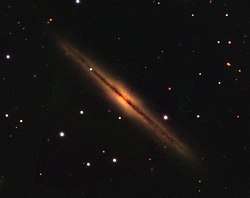NGC 973
NGC 973 is a giant[3] spiral galaxy located in the constellation Triangulum. It is located at a distance of circa 200 million light years from Earth, which, given its apparent dimensions, means that NGC 973 is about 230,000 light years across. It was discovered by Lewis Swift on October 30, 1885.[4]
| NGC 973 | |
|---|---|
 NGC 973 by PanSTARRS | |
| Observation data (J2000 epoch) | |
| Constellation | Triangulum |
| Right ascension | 02h 34m 20.1s[1] |
| Declination | +32° 30′ 20″[1] |
| Redshift | 0.016195 ± 0.000027 [1] |
| Helio radial velocity | 4,855 ± 8 km/s[1] |
| Distance | 195 ± 16 Mly (60.0 ± 4.8 Mpc)[1] |
| Apparent magnitude (V) | 12.8 [2] |
| Characteristics | |
| Type | Sbc [1] |
| Apparent size (V) | 4′.03 × 0′.47 [1] |
| Notable features | Seyfert galaxy |
| Other designations | |
| UGC 2048, CGCG 505-014, MCG +05-07-013, PGC 9795[1] | |
Characteristics
NGC 973 is seen edge-on, with an inclination of nearly 90°.[5] Its bulge is shaped like a box or peanut. The subtraction of axisymmetric components from the profile of the galaxy showed that its bulge has an X-like morphology, which indicates the presence of a bar.[6] A prominent dust lane runs across the galaxy.[7]
The galaxy kinematics revealed that the northeast side is the approaching one and the southwest is receding. The disk appears flat, without warps. The total hydrogen mass of the galaxy is estimated to be about 9×109 M☉,[8] and the total dust mass is estimated to be 1.4×108 M☉, with clumpy distribution.[5] Faint emission from gas lying outside the plane of the galaxy was detected in H-alpha, correlated with the galactic disk and halo.[9]
The nucleus of NGC 973 appears to be active based on its emission. It is categorised as a type 2 Seyfert galaxy.[10][11] The most accepted theory for the energy source of active galactic nuclei is the presence of an accretion disk around a supermassive black hole.
Nearby galaxies
NGC 973 is the largest galaxy in a galaxy group known as the NGC 973 group.[12] The NGC 973 group is one of the largest galaxy groups of the Perseus-Pisces Supercluster,[13] with at least 39 galaxies identified as its members. Other members of the group include NGC 917, NGC 931, NGC 940, NGC 969, NGC 974, NGC 978, NGC 987, NGC 983, NGC 1060, NGC 1066, NGC 1067, and UGC 2105.[14]
NGC 973 forms a pair with IC 1815, which lies 4.6 arcminutes to the south.[15] A small satellite was discovered in HI imaging near the northeast edge of the disk of NGC 973, with no optical counterpart.[8]

References
- "NASA/IPAC Extragalactic Database". Results for NGC 973. Retrieved 2019-01-18.
- "Revised NGC Data for NGC 973". spider.seds.org. Retrieved 25 November 2018.
- Saburova, A. S. (January 2018). "What made discy galaxies giant?". Monthly Notices of the Royal Astronomical Society. 473 (3): 3796–3809. arXiv:1710.01341. doi:10.1093/mnras/stx2583.
- Seligman, Courtney. "NGC 973 (= PGC 9795)". Celestial Atlas. Retrieved 19 November 2018.
- Xilouris, E. M.; Kylafis, N. D.; Papamastorakis, J.; Paleologou, E. V.; Haerendel, G. (1 September 1997). "The distribution of stars and dust in spiral galaxies: the edge-on spiral UGC 2048". Astronomy and Astrophysics. 325: 135–143. Bibcode:1997A&A...325..135X. ISSN 0004-6361.
- Patsis, P. A.; Xilouris, E. M. (11 March 2006). "Boxy/peanut 'bulges': comparing the structure of galaxies with the underlying families of periodic orbits". Monthly Notices of the Royal Astronomical Society. 366 (4): 1121–1125. arXiv:astro-ph/0512244. doi:10.1111/j.1365-2966.2005.09922.x.
- Guthrie, B. N. G. (1 May 1992). "Axial ratios of edge-on spirals". Astronomy and Astrophysics Supplement Series. 93: 255–270. Bibcode:1992A&AS...93..255G. ISSN 0365-0138.
- Allaert, F.; Gentile, G.; Baes, M.; De Geyter, G.; Hughes, T. M.; Lewis, F.; Bianchi, S.; De Looze, I.; Fritz, J.; Holwerda, B. W.; Verstappen, J.; Viaene, S. (30 September 2015). "HERschel Observations of Edge-on Spirals (HEROES) II. Tilted-ring modelling of the atomic gas disks". Astronomy & Astrophysics. 582: A18. doi:10.1051/0004-6361/201526667.
- Miller, Scott T.; Veilleux, Sylvain (October 2003). "Extraplanar Emission‐Line Gas in Edge‐On Spiral Galaxies. I. Deep Emission‐Line Imaging". The Astrophysical Journal Supplement Series. 148 (2): 383–417. doi:10.1086/376604.
- Hiroi, Kazuo; Ueda, Yoshihiro; et al. (1 August 2013). "The 37 Month MAXI/GSC Source Catalog of the High Galactic-Latitude Sky". The Astrophysical Journal Supplement Series. 207 (2): 36. arXiv:1307.2455. doi:10.1088/0067-0049/207/2/36.
- Verstappen, J.; Fritz, J.; Baes, M.; Smith, M. W. L.; Allaert, F.; Bianchi, S.; Blommaert, J. A. D. L.; De Geyter, G.; De Looze, I.; Gentile, G.; Gordon, K. D.; Holwerda, B. W.; Viaene, S.; Xilouris, E. M. (24 July 2013). "HERschel Observations of Edge-on Spirals (HEROES) I. Far-infrared morphology and dust mass determination". Astronomy & Astrophysics. 556: A54. doi:10.1051/0004-6361/201220733.
- Garcia, A. M. (1993). "General study of group membership. II - Determination of nearby groups". Astronomy and Astrophysics Supplement Series. 100 (1): 47–90. Bibcode:1993A&AS..100...47G. ISSN 0365-0138.
- "The Perseus-Pisces Supercluster". www.atlasoftheuniverse.com.
- Crook, Aidan C.; Huchra, John P.; Martimbeau, Nathalie; Masters, Karen L.; Jarrett, Tom; Macri, Lucas M. (October 2008). "Erratum: "Groups of Galaxies in the Two Micron All Sky Redshift Survey" (ApJ, 655, 790 [2007])". The Astrophysical Journal. 685 (2): 1320–1323. doi:10.1086/590385.
- Nilson, P. (1973) Uppsala General Catalogue of Galaxies, Acta Universitatis Upsalienis, Nova Regiae Societatis Upsaliensis, Series V: A Vol. 1
External links
- NGC 973 on WikiSky: DSS2, SDSS, GALEX, IRAS, Hydrogen α, X-Ray, Astrophoto, Sky Map, Articles and images
- NGC 973 on SIMBAD